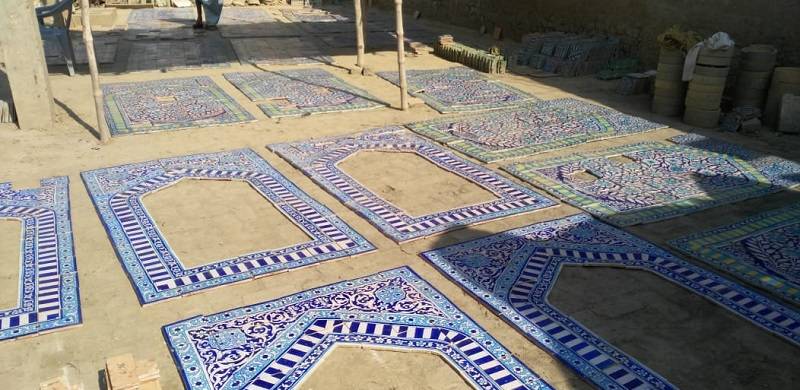
Kashi Kari was once a most prominent craft for beautifying the architectural elements of masjids, temples, shrines, palaces and for decorating pots in the Mughal era. It is now appears to be a dying art, which might soon be forgotten.
The process of Kashi Kari requires time, creativity and enthusiasm, but the craftsmen are no longer appreciated and the majority of people are forgetting its worth and importance. This is similar to how calligraphy is increasingly forgotten in much of Pakistan.
However, in some parts of Pakistan this art is still alive – if only just. Centres of Kashi Kari includge Jafarabad in Balochistan; Lahore and Multan in Punjab; Hala, Thatta and Nasarpur in Sindh; Dera Ismail Khan and Mahra Sharif in Khyber-Pakhtunkhwa.
Wet clay is steeped in dyes and kept in a traditional oven for drying. Colour is filled in or painted and everything is handmade.
Blue Kashi Kari is considered the old mosaic art, with Nasarpur as a centre. The National Indigenous and Traditional Arts (NITA) is one of the prominent organizations to promote Blue Kashi Kari. Hand painting and glazing of earthenware products is a significant art for which this city is well known. NITA was founded in 2012 and aims at promoting this art, especially making Blue Kashi Tiles. The organization is now focusing on Porcelain clay bodies to make high quality tiles, pottery, tables, mosaics and murals.
Nasarpur is an ancient town of the province of Sindh. It was the capital of Sindh during the 14th century. As a centre of trade on the Indus bank, it was host to many craftsmen. Local potters used the loam clay of the riverbed for pottery. The place becmae well known for its traditional handmade arts: textile products, woodwork, traditional foods, Kashi Kari, masonry, etc – all done on a commercial basis. But in the contemporary period all these crafts are dying out.
Kashi Kari is suffering all through the industry, from manufacturing to marketing. In the past many families were engaged in this art. Now there are 3-4 families at best in the town. After Partition in 1947, there is little in the way of exemplary art from Kashikars of Nasarpur.
Ghulam Haider, Founder and Chairman of NITA Crafts Development Co-operative Society, says that Kashi Kari is “an indigenous ceramic taditional art. It has been practiced since 1100 AD in the region from Multan to Nasarpur and then Hala. Nasarpur was a big center for production of this splendid craft. There is dire need to revive and develop it with the highest attention to quality.”
The word Kashi is derived from word 'Kash'. In Persian it means glass.
According to Ghulam Haider, it is a manufacturing activity carried on in people's homes. Most of the artisans are not paid handsome sums of money. Their families rely on this income but the cottage industry is declining day by day.
An artist Imran Ali, who is a traditional Kashi Tiles expert, shared his experience in this field. “Our family is doing this work for decades. We are doing the utmost to save the craft and to spread it among people who are unaware. We request the government to give us space for popularizing the art since the pupils have no accommodation to go properly into the depth of the art. They often can't even find room to sit. Due to low space in Kashi Kari workshops, the students from Universities have to face great difficulties.”
Imran Ali further says that since childhood he has seen clay around him. “I was born in a family with a tradition of working in clay from many generations.”
